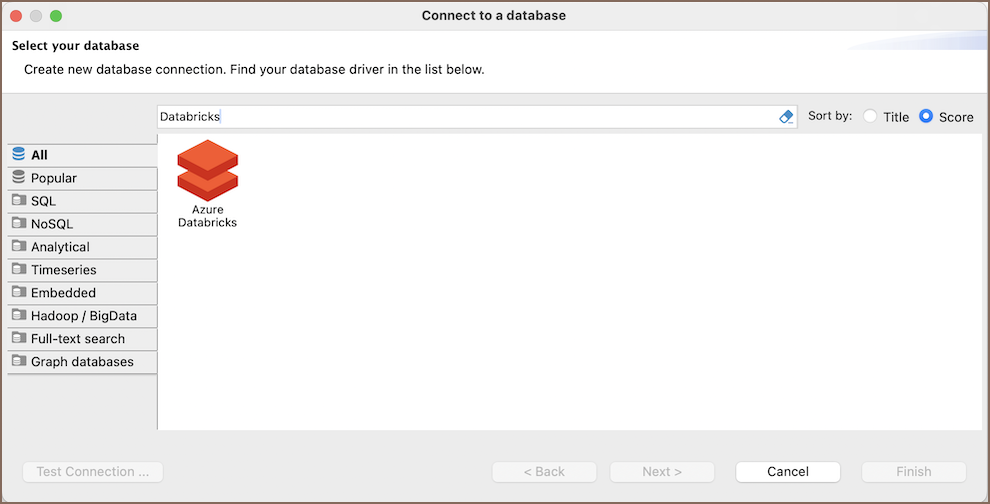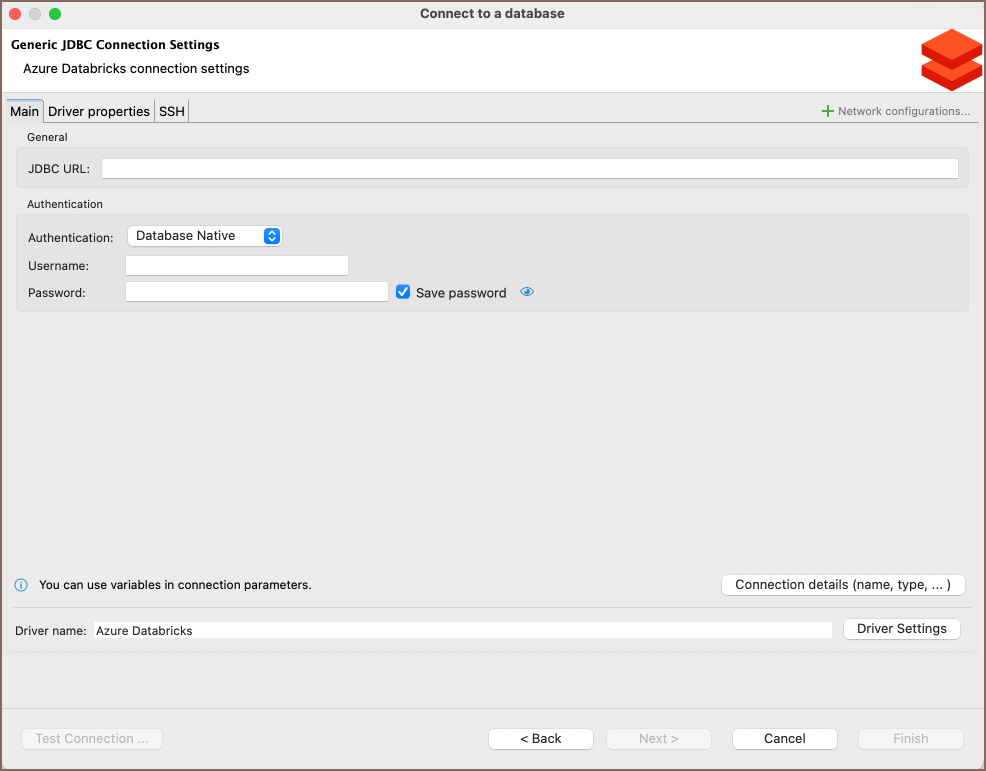Database driver Azure Databricks
Table of contents
Overview
This guide provides instructions on how to set up and use Databricks with DBeaver.
Before you can start managing your database, it's essential to establish a connection in DBeaver. This involves
selecting the Databricks option to connect to the Databricks database. If you have not yet created a
connection in DBeaver, please refer to our Creating a Connection article for guidance.

Databricks specialty
Azure Databricks, based on Apache Spark, is a distributed computing system primarily used for machine learning and big data analytics. Its architecture is specially optimized for handling large-scale data processing and advanced analytics tasks. Azure Databricks integrates with MLlib in Apache Spark, offering scalable algorithms and utilities for machine learning tasks. It also facilitates collaborative work through its notebooks, allowing teams to share code, visualizations, and insights effectively. For more detailed information and a comprehensive understanding of Azure Databricks, please refer to the official documentation.
In the section you can find features supported by DBeaver that are compatible with Azure Databricks.
Setting up
This section provides an overview of DBeaver's settings for establishing a direct connection and the configuration of secure connections using SSH and proxies for Databricks.
Databricks connection settings
In this subsection, we will outline the settings for establishing a direct connection to a Databricks database using DBeaver. Correctly configuring your connection ensures seamless interaction between DBeaver and your Databricks database.
The page of the connection settings requires you to fill in specific fields to establish the initial connection.

| Field | Description |
|---|---|
| JDBC URL | Enter the URL of your Databricks database here. |
| Authentication | Choose the type of authentication you want to use for the connection. For detailed guides on authentication types, please refer to the following articles: - Native Database Authentication - DBeaver Profile Authentication You can also read about security in DBeaver PRO. |
| Connection Details | Provide if necessary. |
| Driver Name | This field will be auto-filled based on your selected driver type. |
| Driver Settings | If there are any , configure them here. |
Connection details
The Connection Details section in DBeaver allows you to customize your experience while working with a Databricks database. This includes options for adjusting the Navigator View, setting up Security measures, applying Filters, configuring Connection Initialization settings, and setting up Shell Commands. Each of these settings can significantly impact your database operations and workflow. For detailed guides on these settings, please refer to the following articles:
- Connection Details Configuration
- Database Navigator
- Security Settings Guide
- Filters Settings Guide
- Connection Initialization Settings Guide
Databricks driver properties
The settings for Databricks Driver properties enable you to adjust the performance of Databricks JDBC driver. These adjustments can influence the efficiency, compatibility, and features of your Databricks database.
For a complete walkthrough on setting up Databricks JDBC driver properties, you can refer to the official Databricks JDBC documentation. These guides detail each driver's properties and how they can be used to optimize Databricks database connections.
You can customize the Databricks driver in DBeaver via the Edit Driver page, accessible by clicking on the Driver Settings button on the first page of the driver settings. This page offers a range of settings that can influence your Databricks database connections. For a comprehensive guide on these settings, please refer to our Database drivers article.
Secure connection configurations
DBeaver supports secure connections to your Databricks database. Guidance on configuring such connections, specifically SSH, Proxy, and Kubernetes connections, can be found in various referenced articles. For a comprehensive understanding, please refer to these articles:
Powering Databricks with DBeaver
DBeaver provides a host of features designed for Databricks databases. This includes the ability to view and manage databases, along with numerous unique capabilities aimed at optimizing database operations.
Databricks database objects
DBeaver lets you view and manipulate a wide range of Databricks database objects. DBeaver has extensive support for various Databricks metadata types, allowing you to interact with a wide variety of database objects, such as:
Databases
- Tables
- Columns
- Keys
- Foreign keys
- References
- Views
- Procedures
- Tables
Databricks Features in DBeaver
DBeaver is not limited to typical SQL tasks. It also includes numerous additional features compatible with Databricks, but not exclusive to it:
| Category | Feature |
|---|---|
| Data Transfer | Data Import |
| Data Export | |
| Data Visualization | ERD Guide |
| Data Generation | Mock Data Generation |
